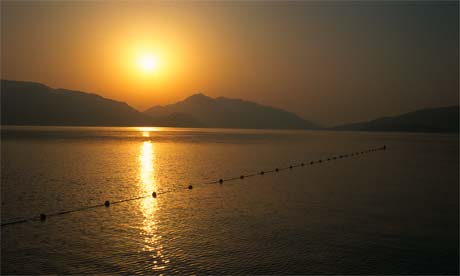Link to pdf file with links to candidates (begins on page 3): http://www.columbia.edu/~jeh1/mailings/20081023_Obstruction.pdf
Congressman Tim Walberg Named Latest Member of the 2008 Dirty DozenWASHINGTON, DC, October 14, 2008 - The League of Conservation Voters (LCV), which works to turn environmental values into national priorities, today announced that U.S. Rep. Tim Walberg of Michigan's 7th District has been named to its 2008 "Dirty Dozen" list.
LCV's trademark Dirty Dozen program targets candidates for Congress — regardless of party affiliation — who consistently vote against clean energy and conservation and are running in races in which LCV has a serious chance to affect the outcome. Since the Dirty Dozen was launched in 1996, LCV has defeated more than half of the candidates named to the list. In 2006 alone, LCV ousted several supposedly "undefeatable" incumbents such as former House Resources Chairman Richard Pombo and former Senator Conrad Burns....more
Anne Northup Named to 2008 Dirty DozenWASHINGTON, DC, October 14, 2008 - The League of Conservation Voters, which works to turn environmental issues into national priorities, today added Anne Northup to its 2008 Dirty Dozen list.* Northup has a lifetime score of only 7% on LCV's National Environmental Scorecard and voted against every major piece of environmental legislation in the 109th Congress.
"With energy at the heart of the 2008 election, it is critical that we elect Representatives who will steer us away from Big Oil and toward a clean, renewable energy policy," said LCV Deputy Legislative Director Tim Greeff. "Anne Northup has a deplorable environmental record and promises to continue our reliance on oil and minimize investment in alternative energy sources." ...more
Don Young Joins the 2008 Dirty DozenWASHINGTON, DC, October 2, 2008 - WASHINGTON, DC –The League of Conservation Voters (LCV), which works to turn environmental values into national priorities, today added Alaska Congressman Don Young to its 2008 “Dirty Dozen” list.* Young’s abysmal record on energy issues makes him one of this year’s worst candidates for re-election to the US House of Representatives.
“Alaska is the frontline of global warming. As their homes and businesses slide into the sea, the people of Alaska deserve a Representative who will fight for real solutions, not oil company profits,” said LCV President Gene Karpinski. “Don Young has repeatedly blocked legislation that would raise fuel efficiency in our cars; repeal subsides for oil conglomerates, and invest in clean renewable energy, working instead to pad the pockets of Big Oil interests at home and in Washington.”...more
LCV Urges Voters to Turn Out the Lights on Senator DoleWASHINGTON, DC, September 15, 2008 - The League of Conservation Voters (LCV), which works to turn environmental values into national priorities, today announced that Senator Elizabeth Dole (R-NC) has been named to its 2008 “Dirty Dozen” list. Dole has a lifetime score of only 4% on LCV’s National Environmental Scorecard.*
“Senator Dole’s record proves that she’s working in the best interests of Exxon/Mobil, not the people of Raliegh/Durham. For Chevron, not the people of Charlotte. For the lobbyists of big oil, not the people of small town North Carolina,” LCV Senior Vice President Tony Massaro said.
“Instead of protecting clean water and clean air for our health or developing clean energy for our children, she votes in favor of oil company profits every time.”...more
Dean Andal Takes Pombo’s Place in the 2008 Dirty DozenWASHINGTON, DC, August 14, 2008 - The League of Conservation Voters (LCV), which works to turn environmental values into national priorities, today added Dean Andal to its 2008 “Dirty Dozen” list.* Andal’s abysmal record on energy and environmental issues make him one of the worst candidates for federal office in the nation. “Californians are paying over $4.50 per gallon for gasoline, and deserve a representative who will work to end our nation’s dependence on oil, and fight for alternative energy sources,” LCV Senior Vice President Tony Massaro said.
“Andal has consistently voted against fuel efficiency programs and measures to slow global warming. His current proposals echo the failed policies of the Bush Administration that created the situation we’re in now. If elected, Andal will help the oil industry dismantle the laws that protect California’s coastline from oil spills from tankers and offshore drilling while doing nothing to reduce the price of gasoline.”...more
Congressman Sam Graves Earns Dubious Distinction as Member of 2008 Dirty DozenWASHINGTON, DC, August 12, 2008 - The League of Conservation Voters (LCV), which works to turn environmental values into national priorities, today added Congressman Sam Graves (MO-6) to its 2008 “Dirty Dozen” list.* Graves has earned an abysmal lifetime LCV score of only 4% on energy and environmental issues. He has accepted $63,983 from the oil & gas industry.
“While the people of Missouri are paying record prices at the pump, the oil companies are handing that money right back to Sam Graves,” LCV Senior Vice President Tony Massaro said.
“Is it any wonder that he keeps voting to give those same oil companies billions of our tax dollars? Thanks to Sam Graves, we’re paying Exxon twice for the same gas – once at the pump and again with the tax dollars that could be going to schools, to veterans, or to developing new sources of energy that would create thousands of jobs in Missouri.” ...more
LCV Adds Senator Ted Stevens (R-AK) to 2008 "Dirty Dozen"WASHINGTON, DC, July 1, 2008 - The League of Conservation Voters (LCV), which works to turn environmental values into national priorities, today announced that Senator Ted Stevens (R-AK) has been named to its 2008 “Dirty Dozen” list. Stevens holds a lifetime score of only 14% on the LCV environmental scorecard.
“For forty years in the Senate, Ted Stevens has stood in the way of progress. Today, he literally lives in the house that oil built,” LCV President Gene Karpinski said. “With his scandalous ties to the oil industry finally exposed, Alaska has the chance to let Mr. Stevens retire to that nice house.”
Stevens has consistently voted for billions of dollars in tax breaks for oil companies since 1977. Oil and gas interests have given more than $460,000 in campaign contributions to Stevens’s campaigns. Last July, the FBI raided Stevens’s home in search of records documenting his connection to Bill Allen, an executive of the Veco oil services company, which reaped millions in federal contracts and who was convicted of bribery. Allen’s contracting business doubled the size of Stevens’s home. Stevens is under federal investigation. ...more
LCV Adds Senator Mary Landrieu to 2008 "Dirty Dozen"WASHINGTON, DC, July 1, 2008 - The League of Conservation Voters (LCV), which works to turn environmental values into national priorities, today added Senator Mary Landrieu (D-LA) to its 2008 “Dirty Dozen” list.* Her lifetime LCV Score of 43% ranks her the worst Democrat in the Senate on environmental issues currently running for reelection. **
Last week, Dr. Thomas Fingar, the Chairman of the National Intelligence Council testified that global warming poses a significant risk to America’s national security, and that “some parts of the United States—particularly built-up coastal areas—will be at greater risk of extreme weather events.” In the wake of Hurricane Katrina, Louisiana’s representatives should be leading the charge in the fight against global warming.
“For a Senator from Louisiana, which faces severe consequences from global warming, to fail to protect Louisiana is disappointing,” LCV Senior Vice President for Political Affairs and Public Education Tony Massaro said. “Senator Landrieu joins the DD because she acts more to protect Big Oil than the future for the people of Louisiana.” ..more
LCV Adds Congressman Steve Pearce to 2008 "Dirty Dozen"WASHINGTON, DC, July 1, 2008 - The League of Conservation Voters (LCV), which works to turn environmental values into national priorities, today added Congressman Stevan Pearce (R-NM) to its 2008 "Dirty Dozen" list.* Pearce’s record of extremism marks him as one of the twelve worst members of Congress currently up for election.
"During his five years in Congress, Steve Pearce has voted consistently against the environment," LCV Senior Vice-President for Political Affairs and Public Education Tony Massaro said. "Of the 80 conservation key votes since he has been elected, Pearce has voted against clean air, clean energy, protecting the nation's wildlife, and preserving our natural heritage in all but one vote."
Pearce's lifetime LCV score is an embarrassing 1%. He has earned three 0% scores in his tenure and his highest annual score was 5% in his first year.** His opponent, Tom Udall, has earned a 96% lifetime LCV score.
In addition to owning millions of dollars of stock in Key Energy, a Texas-based oil services company, Steve Pearce has accepted more from the oil and gas industry, $556,649, than from any other economic sector. He has voted to give more than $14 billion in tax breaks to the oil industry, opposed renewable electricity, and fought against fuel efficient cars that would save New Mexico families hundreds of dollars at the pump...more
LCV Adds Senate Minority Leader Mitch McConnell to 2008 "Dirty Dozen"WASHINGTON, DC, April 10, 2008 - The members of the League of Conservation Voters (LCV), the independent political voice for the environment, today voted Senate Minority Leader Mitch McConnell (R-KY) to the 2008 "Dirty Dozen" list.
LCV members voted online to decide which 2008 candidate had committed the most egregious offenses against the environment. 25,000 concerned citizens voted for the next member of the "Dirty Dozen," and chose Sen. McConnell by an overwhelming margin.
"Our members know that Mitch McConnell has voted against our health and safety since he came to Washington. They know that he stands as an impassable roadblock in the way of a clean energy future for this country," said LCV President Gene Karpinski. "They know that it is time to tear down this roadblock. That's why McConnell, this 'Godfather of Green,' is the new 'Don' of the Dirty Dozen."..more
LCV Adds Former U.S. Rep. Bob Schaffer to 2008 "Dirty Dozen"WASHINGTON, DC, Jan. 24, 2008 - The League of Conservation Voters (LCV), the independent political voice for the environment, today announced that former U.S. Rep. Bob Schaffer (R-CO) has been named to its 2008 "Dirty Dozen" list.
During his tenure in Congress, Bob Schaffer worked to get Big Oil $33 billion in tax breaks by supporting an energy bill written by Dick Cheney and the oil industry. After leaving the House, he went to work for Big Oil. Now he wants to return to Washington to work for them in the Senate," said LCV Senior Vice President and Colorado native Tony Massaro. "Coloradans deserve a senator who works for them, not Big Oil."..more
MOST IMPORTANT SENATE RACES:COLORADO US SENATE: Mark Udall has been a leader on renewable energy since his time in the Colorado State House, and as Co-Chair of the House Renewable Energy and Energy Efficiency Caucus, he fights to expand America's commitment to renewable energy every day. His lifetime LCV score is 99%. RUNNING AGAINST REPUBLICAN STEVE PEARCE
NEW MEXICO US SENATE: Tom Udall has fought to defend America's wild spaces and led the first successful effort to pass meaningful renewable electricity standards in the House in 2007. His lifetime LCV score is 96%. RUNNING AGAINST SCHAEFFER
NEW HAMPSHIRE US SENATE: Former Governor Jeanne Shaheen of New Hampshire worked with members of both parties to reduce greenhouse gas emissions and other pollutants and has pledged to fight for clean energy as a US Senator. RUNNING AGAINST INCUMBENT JOHN E. SUNUNU














